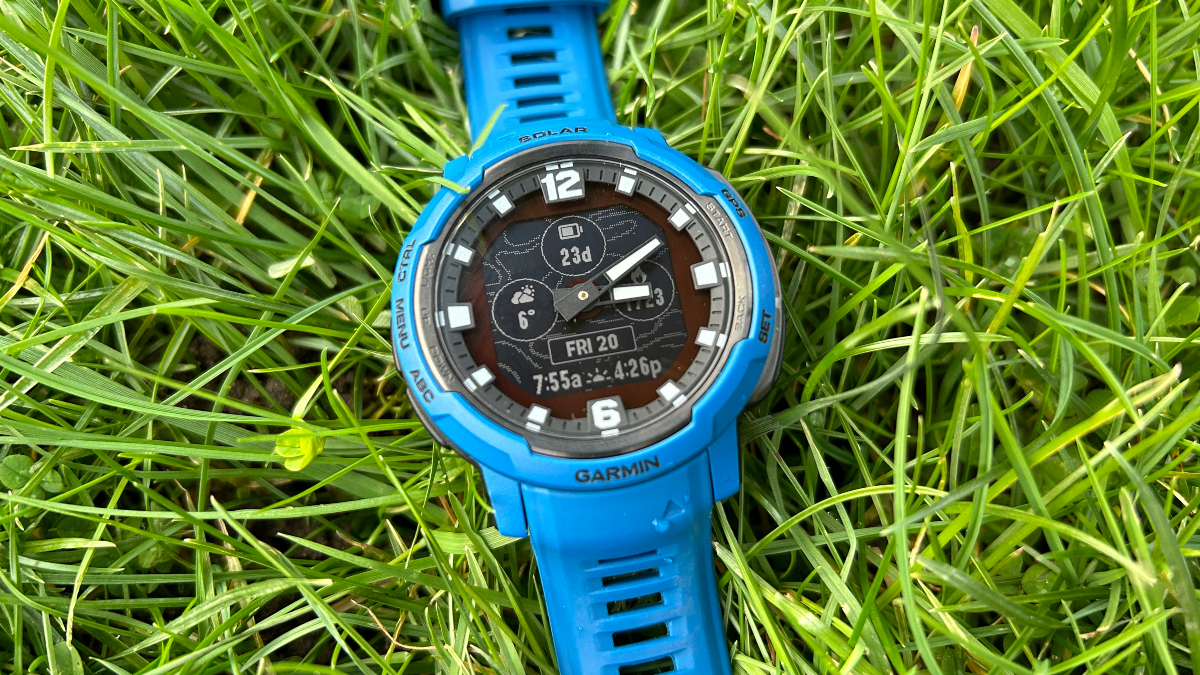Our Verdict
The Garmin Instinct Crossover will no doubt make some people very happy thanks to its distinctive design, and it works as well as you’d expect from a Garmin sports watch. However, there is better value to be found in the company’s range.
For
- Unique look
- Accurate tracking
- Long battery life
Against
- Instinct 2 is much cheaper
- Cluttered, hard-to-read display
- No dual-band GPS
You can trust Coach
The Garmin Instinct Crossover is an upgrade on the Garmin Instinct 2 and a new style, with an analogue display over a digital screen. It’s novel, and will no doubt appeal to some, but it’s also more expensive than the Instinct 2 with few upgrades in performance.
While I don’t rate the Instinct Crossover as one of the best sports watches, it is still a very good tracker. If the design appeals and the price doesn’t put you off, it’s a solid option.
Garmin Instinct Crossover Review: Price And Availability
The Garmin Instinct Crossover launched in November 2022 and comes in three models. The standard watch costs $499 in the US and £479.99 in the UK, the solar model is $549/£529.99 and the Instinct Tactical Solar is $599/£569.99. The latter has extra features, including a stealth mode.
It’s a big jump in price on the Garmin Instinct 2, which costs $349.99/£299.99 for the base model and $449.99/£389.99 for the solar watch, and is often in sales.
Design
Thinking of buying the Garmin Instinct Crossover? If so, that will almost certainly be down to the design. The Instinct already has a distinctive look compared with Garmin’s other watches, and the addition of hands and an analogue dial makes for an even bolder statement.
It’s not a design I liked initially, but I have warmed to the Crossover over time. However, I still prefer the more conventional look of the Forerunner and Fenix watches in Garmin’s range. There are only blue and black colour options in the Instinct Crossover range for now, whereas the larger Instinct 2 range contains brighter colours, like yellow and green watches.
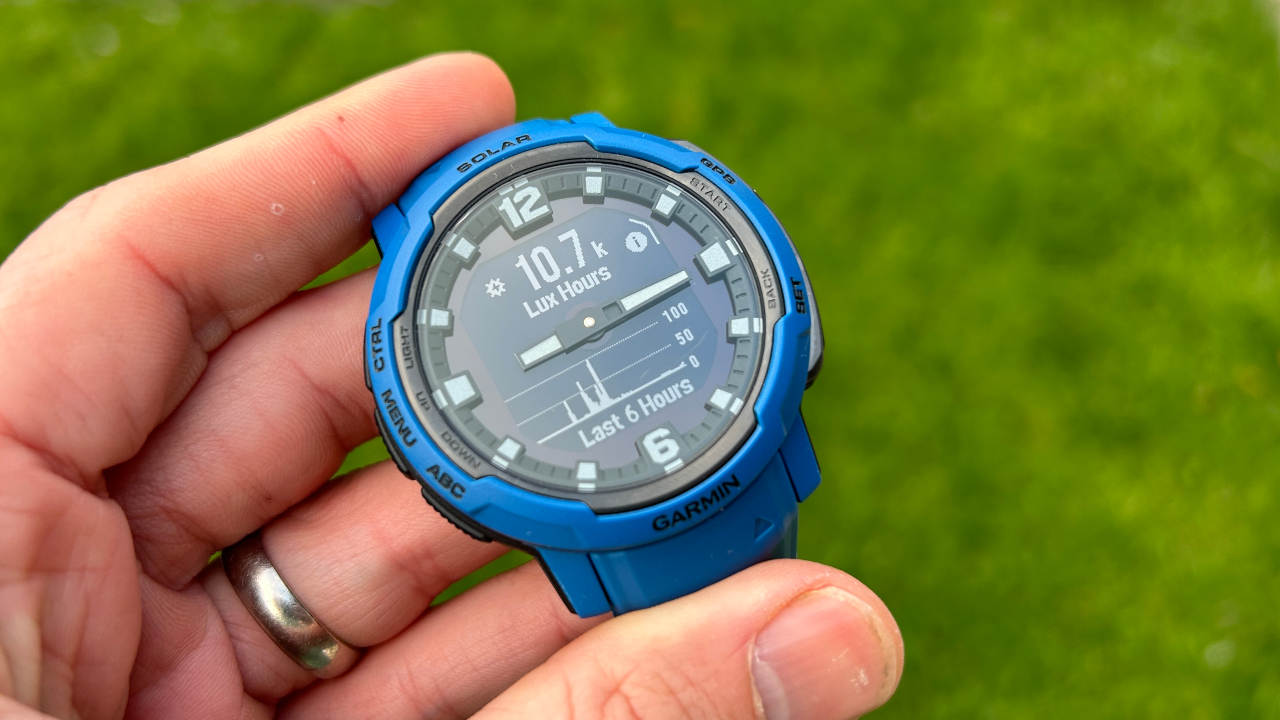
The watch’s hands are clever, constantly moving out of the way to ensure you can see the information on the digital screen behind them. This is a 0.9x0.9in (23x23mm) memory-in-pixel display with a backlight, a fairly standard Garmin display that’s not the easiest to read at a glance, even with the hands dancing around trying to get out of the way. Rather than having a divided screen, like the Instinct 2, the display on the Instinct Crossover is a full square. Well, nearly – it’s a square with cut-off corners.
Garmin has used a “Super-LumiNova” coating on the hands and analogue dial so they glow in the dark after being “charged up” by light. This doesn’t work well in my experience, but the backlight on the watch does, so you can still see the time in the dark.
Outside of the new analogue designs, the main upgrade in hardware on the Instinct Crossover is a GPS chipset that allows for all-systems-on GPS tracking. This means the watch can use five satellite systems at once to track outdoor activities, as opposed to two at once on the Instinct 2.
This falls short of the multi-band GPS tracking available on many Garmin watches, including cheaper ones like the Garmin Forerunner 255, so it’s surprising to see this left off the Instinct Crossover. Given the price and its intended purpose as an adventure watch, having the best possible GPS as an option seems natural, even if you want to turn it off sometimes to save battery.
Other than this the Instinct Crossover has all the same hardware features as the Instinct 2. It has five buttons, a pulse oximeter and a barometric altimeter, and a waterproof rating of 10 ATM. As with all Instinct watches, its rugged case is made from fibre-reinforced polymer.
The solar version of the watch uses a Power Glass display and has solar panels around the display to soak up sunlight, while the standard Instinct Crossover has a strengthened glass display.
How I Tested This Watch
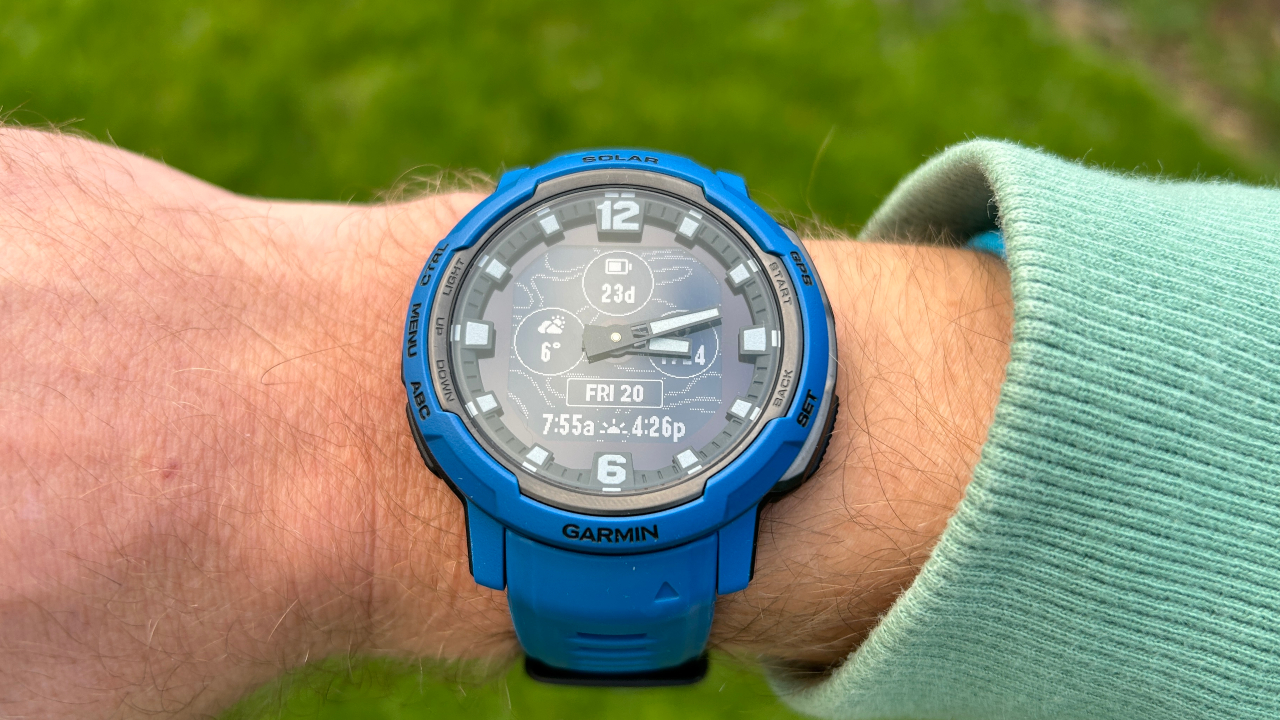
I have worn the Garmin Instinct Crossover Solar for the past few weeks to track my daily activity, sleep and workouts, I have also tested the Garmin Instinct 2 and Instinct Solar, plus most of Garmin’s other watches. During exercise I tested it against the Garmin Epix 2 linked to a Garmin HRM-Pro Plus chest strap to check the GPS and heart rate accuracy.
Sports Tracking
The Instinct Crossover is a highly effective sports tracker. It offers a multitude of sports modes and the GPS accuracy was mostly accurate in my experience, if sometimes missing quirks on a route that the Garmin Epix 2 would catch with its multi-band GPS mode.
I had more problems with the heart rate accuracy, which would often read too high for long sections of runs, something that then skews the training analysis provided by the watch. This is pretty comprehensive, giving you details like your VO2 Max and analysis of your training load to ensure it is balanced, but lacks some of Garmin’s top features, like training readiness, which is reserved for more expensive watches in its range.
The Instinct Crossover can also suggest running and cycling workouts for you to do each day based on its analysis of your training. This is now a common feature on Garmin watches and the workouts do succeed in balancing your training and helping you get fitter. You can also disable the prompts of the suggested workouts if you have your own plan to work to.
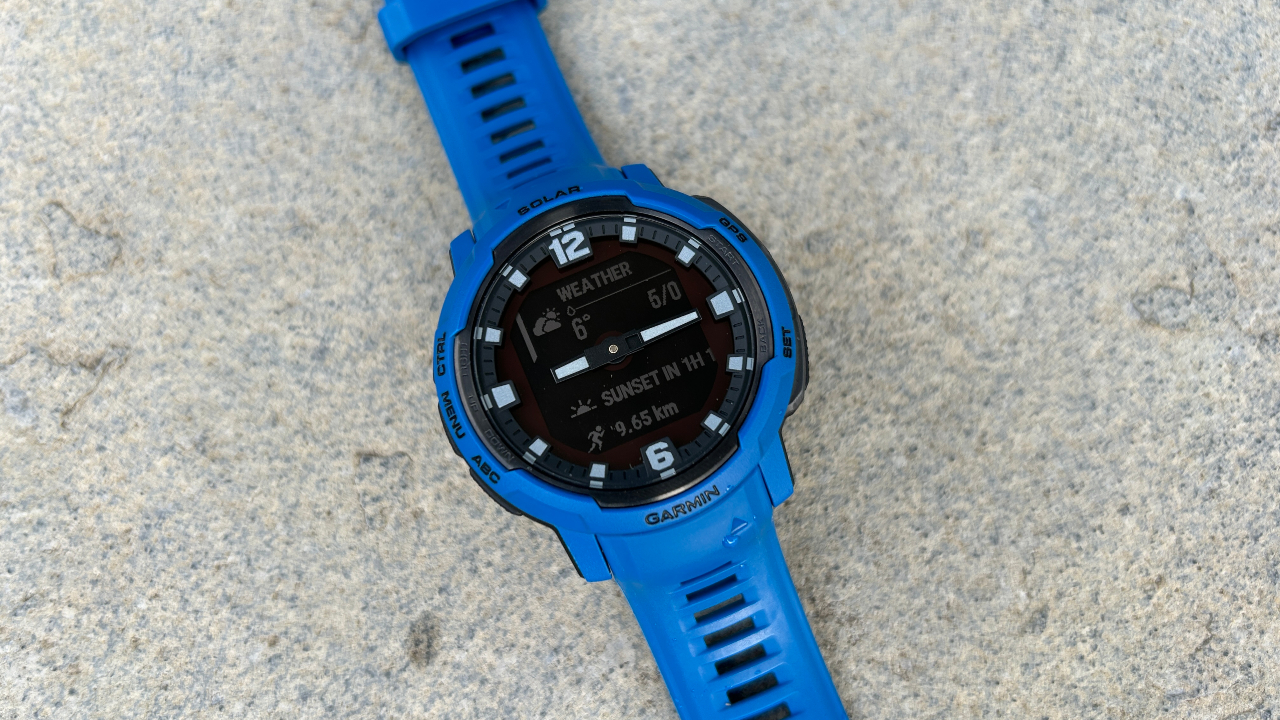
I’d pair a chest strap with the Instinct Crossover to get the most reliable heart rate data, especially when running, but if you’re mainly using it for hikes the optical monitor is reliable enough.
The main problem I had with the Instinct Crossover during workouts was that the screen wasn’t that easy to read at a glance during higher-intensity workouts, like runs. That’s partly the lack of real estate – it’s a small screen further cluttered by the hands – but it’s also set back from the glass and a little dim when the backlight isn’t on. It’s not a terrible display, but it’s less clear than the screens on Garmin’s Forerunner range.
Battery Life
The Instinct range in general is noted for its battery life, and the Instinct Crossover excels on this front. It’s listed as lasting 28 days in smartwatch mode and offering 25 hours of GPS, with the latter being in all-systems-on satellite mode, so you can make it last longer by opting for GPS only. If you use the Solar version of the watch you can get up to 70 days of battery life in smartwatch mode, and 31 hours of GPS, in sunny conditions.
I was a little short of sun during my testing of the watch, but it still lasted up to 14 days on a charge tracking regular outdoor runs. Compared with the Instinct 2, the Crossover drains a little faster for me, mainly because of the more accurate GPS mode available on the Crossover, but the Crossover offers more juice than the Instinct 2 in its power-saving max battery and expedition modes.
Navigation Features
The Instinct Crossover doesn’t have the full maps you get on Garmin’s watches, but has breadcrumb navigation with turn-by-turn directions, as well as a back-to-start feature that will navigate you to your starting point, either with a straight line pointer or by following your footsteps back. You can also navigate to waypoints using the watch.
While you do get an elevation plot of your route, the Instinct Crossover doesn’t have ClimbPro, which breaks down the climbs and descents in your route to help you manage your efforts.
Navigating using the Instinct Crossover is made a little harder by the small screen, and the hands, but it’s still a great tool for finding your way around, if not as good as Garmin’s watches with maps.
Activity And Sleep Tracking
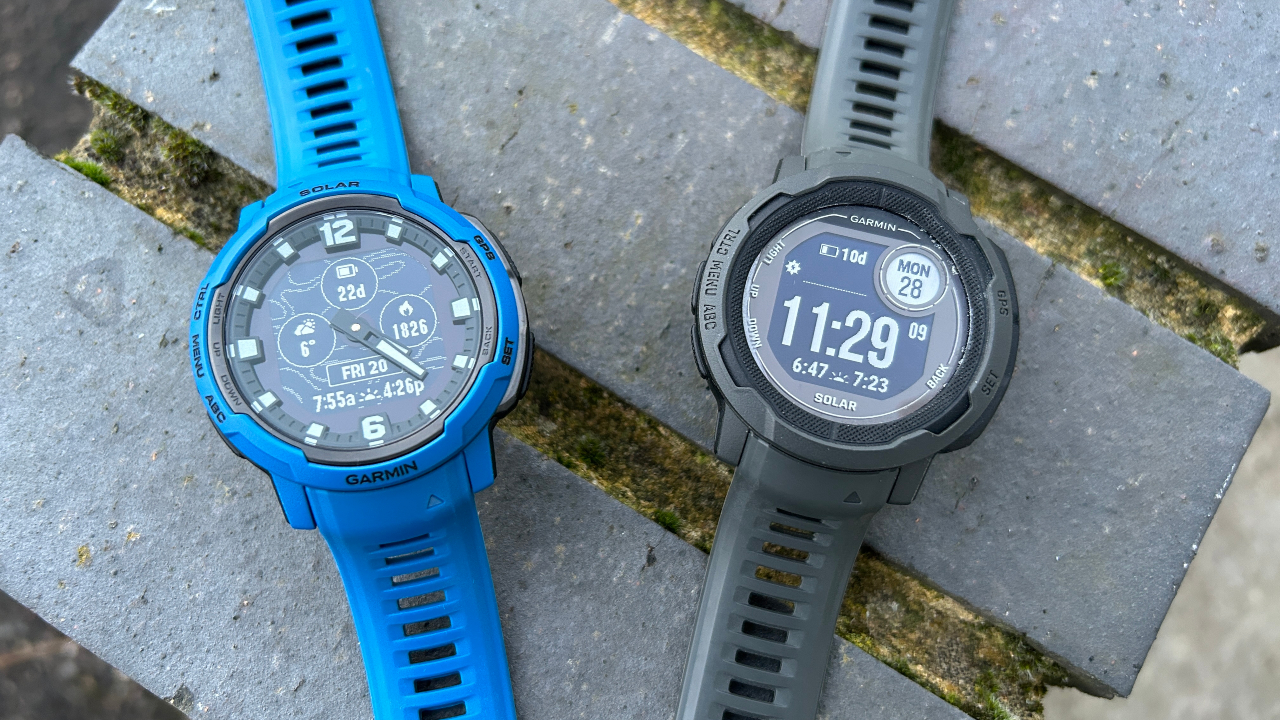
The Instinct Crossover tracks all your everyday activity, and the active hands will actually move to show how close you are to hitting your step goal when you open up that widget. As with all Garmins you can set the step goal to adjust automatically in line with your activity levels, so you always have an appropriate target.
I found the Crossover a little bulky and annoying on a couple of nights and took it off, but mostly it was fine to wear for sleep tracking, and it turns in a sleep score and breakdown of your sleep stages in the morning. The Crossover missed some periods when I was awake but inactive, classing them as light sleep, but overall its sleep readings were in line with how I felt and it caught any really bad nights, such as one spent tossing and turning after a few drinks.
The Instinct Crossover also monitors your heart rate variability status each night and once you’ve established your baseline, it will tell you each morning if your HRV is inside or outside your normal range. If outside, it can be a sign your body is under stress and easing off your training that day might be advisable.
Smart Features
While the Instinct Crossover doesn’t offer music storage, it does have most of Garmin’s other smart features, including Garmin Pay. You can control music playback on your phone and get your notifications and calendar appointments on the watch, as well as seeing the weather forecast.
The Instinct Crossover also supports Garmin Connect IQ app store. The range of apps available isn’t huge, but there are lots of watch faces and extra data fields you can add.
Is The Garmin Instinct Crossover Worth It?
For the Garmin Instinct Crossover to be worth it you have to be a huge fan of its hybrid analogue design because that is the main selling point over the cheaper Instinct 2. Based on my testing, the other updates on the watch don’t significantly change the user experience, so it’s all about the hands and whether you get on with the cluttered display.
It’s a good sports watch, offering the usual excellent Garmin experience, but if sports tracking is a priority the Forerunner 255 has dual-band GPS and a lighter design, with a screen that’s easier to ride when running or cycling. The price of the Instinct Crossover is also high enough to get pretty close to the base models in the Garmin Fenix 7 range, which offer full maps and music storage, as does the Garmin Forerunner 955 for a similar price.
The Instinct Crossover is an interesting addition to Garmin’s range, but not a strictly necessary one in my opinion, and it’s not a watch that offers great value on features alone.

Nick Harris-Fry is a journalist who has been covering health and fitness since 2015. Nick is an avid runner, covering 70-110km a week, which gives him ample opportunity to test a wide range of running shoes and running gear. He is also the chief tester for fitness trackers and running watches, treadmills and exercise bikes, and workout headphones.
